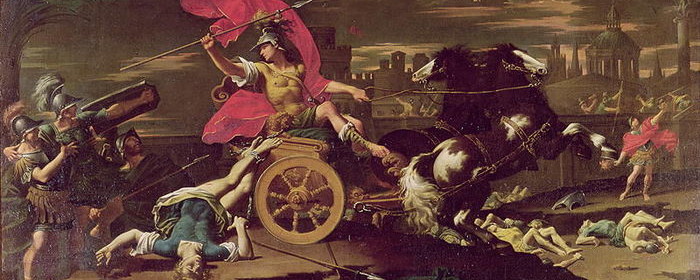The Iliad

was midnight, his father was repairing a tape recorder; his mother was manually winding a radio transformer by means of a manual hand drill fixed horizontally onto a work bench; his four siblings were fast asleep. He was awake reading what must be read, before the dawn.He wouldn’t call off it for the following day, since the day after the following day, all of them would be in a day long journey on a locomotive train “Udarata Menike” [Sinhala: Highland Belle] powered by Canadian diesel electric engine leaving Colombo Fort to reach the highlandsanitarium, the military canton town of Diyatalawa, 47 km south of Sri Lanka Holidays Nuwara Eliya. It was December school vacation. Little did he know, herein his hands was a masterpiece. Little did he know that the was reading a lynch pin of the western canon. Little did he know it was the favorite book of Alexander the Great himself, his very first foreign hero. Little did he know what he had already been experiencing, was preciously what the original writer of the story had etched into immortality: the human soul in its duel
form; good and bad; the man’s violence upon man. Then on an equal footing was the conceptions of heroism and honour tied to the reality of tragedy. He was eight. He read the whole story cover to cover before the crack of the dawn and dreamt it night after night for a fortnight in the salubrious climate of Diyatalawa, one of the sanatariums encompassed in Ceylon Health Triangle of Sri Lanka. It was “Ranabima” [Sinhala: the battlefield], David Karunaratne’s Sinhalese translation of Homer’s “The Iliad”.Written bybunpeiris.
But Ilioneus’ mother had given Phorbas no other child, and now this only son was struck by Penelos under the eyebrow in the socket of the eye. The spear dislodged his eyeball, pierced the socket & came out at the nape of the neck. He sank down and stretched out both his hands. But Penelos, drawing his sharp sword, hit him full on the neck & brought head & helmet tumbling to the ground. The heavy spear was till struck in the eye as Penelos raised it aloft, like a poppy-head, for the Trojans to see, & exulted over his enemy. “Trojans’” he cried “be so good as to instruct the father & mother of my lord Ilioneus to start lamenting him at home….”
Homer in his epic poem [ remember he was blind, illiterate and sang it at Greek temples] the Iliad, is ambiguous as to the sin of Helen, wife King Menelaus was seduced to elope or abducted by the Trojan Prince Paris. Then again Helen of Troy was no stranger to either seduction or abduction: she has already been abducted by (or had eloped with) Theseus, and bore him a child.
In Greek mythology, Helen of Troy, also known as Helen of Sparta [her husband Menelaus being the king of Sparta] evokes mixed sentiments for ever: she caused to a thousand Greek ships sail; desturction of the kingdom of Troy. Helen of Troy was the daughter of Supreme Greek god Zeus, reigning at Mount Olympus and Leda, formerly wife of king Tyndareus, then seduced by God King Zeus. The birth of Helen of Troy too is as mythical as that of goddess Aphrodite, who was floated ashore on a scallop shell. Helen of Troy was hatched by her mother, Leda, from an egg.
Heinrich Schliemann and the discovery of Troy, the battleground of “The lliad” of Homer
The city we call Troy, founded about 2920 BCE, was destroyed at least nine times and was home to various groups over its rocky history. The Greeks could be called the first “discoverers” of Troy because they founded the town of Ilion on the site after 300 years of abandonment, sometime around 700 BCE. They thought their Ilion was on the location of the legendary Trojan War.The city was abandoned about 1500 AD and forgotten. In 1868, German-American adventurer Heinrich Schliemann arrived at Troy’s location.He had heard the claim of Frank Calvert, an Englishman who was living there, that the hill called Hisarlik was likely to be hiding the ruins of Troy. After walking the site and reading the on a rooftop for two hours, Schliemann wrote, “I was fully convinced that it was here that ancient Troy had stood.” A wealthy man, Schliemann could pay for a big archaeological dig. However, the science of archaeology was very new, and Schliemann made mistakes. For example, he told the world about a set of beautiful artifacts that he labeled “The Treasure of Priam.”He even had his wife dress up wearing some of the lovely gold jewelry. Schliemann was sure that the treasure was from the Troy of the Trojan War.
After his death, Schliemann’s assistant Wilhelm Doerpfeld proved the treasure was part of Troy II, much earlier than the Trojan War could have been. Doerpfeld worked at Troy for many years, and it was he who identified the nine basic layers of the city, and labeled them with the system in Roman numerals that is still used today. Doerpfeld favored Troy VI as the fabled Troy. In 1932, he agreed to American archaeologist, Carl Blegen of the University of Cincinnati, to work on the site. Blegen and his crew kept full scientific records and used pottery to date parts of the site more accurately. It was Blegen who determined that Troy VII was the likeliest time for the Trojan War, based on evidence of burning and siege.So, is the discovered Troy the “real” Troy?
Scholars disagree on whether it’s the location of the war on which the legends were based. In fact, the legends may have been based on a series of wars, or on fragments of memory, or on imagined events.What we do know is that the Troy Schliemann, Doerpfeld, and Blegen rediscovered is real, and tells us a lot about how people lived over many centuries.
Troy is still being discovered today. Beginning in 1988, archaeologists from the University of Tübingen, Germany and the University of Cincinnati, under the direction of the late German archaeologist Manfred Korfmann, found many exciting things, including a Mycenean cemetery at Besik Bay, south of Troy, which suggested the landing place of the invading Greeks in the Trojan War. They found that the city extended out onto the plain, where fences and ditches kept enemies out, and found ample evidence of late layers built by the Greeks and Romans who themselves believed that the Trojan War had happened there, and was their own history. http://cerhas.uc.edu/troy/q415b.html
Iliad is no longer an epic poem: it is history, that is since the discovery of Troy in Turkey
Description – Ilus, the son of Tros founded Troy in 3000 BC, and the name Troy was derived from him.
Immortalised by the writings of Virgil and Homer, the ruins of Troy were first found by Charles McLaren in 1822 (2), and excavated by Dr. Heinrich Schliemann, in 1870. The city of Troy was re-discovered after a lifelong quest which led Dr. Schliemann to the plain of Troad, on the north-west coast of Turkey. Until its discovery, it was considered a fictional city in the ‘Illiad’, by Homer. The discovery is one of several ‘mythological’ places that have unearthed in the last two hundred years.
Dr. Schliemann discovered four settlements or cities beneath Illium, one below the other at Hissarlik, of which he determined the third deepest to have been Troy proper, where he found the so called ‘Priam treasures’. ‘These four cities were separated from each other by layers of ash and other marks of conflagration’ (1). The German archaeologist Heinrich Schliemann excavated Troy from 1870 to 1890. His theft of treasure from Troy and his damage to the site will be always remembered in Turkish archaeological history. Wilhelm Dorpfeld followed to excavate Troy after Schliemann. Today, a new German team is still working to rebuild Troy ruins by using new advanced technologies since 1988.
Chronology – There are nine levels at Troy; Troy I to V relates roughly with early Bronze Age (3000 to 1900 BC). Its inhabitants were known as Trojans in this period. Troy VI and VII were built in the Middle and Late Bronze Age. Troy VIII to IX belongs to Hellenistic and Roman Ilion (Latin Ilium). Troy was destroyed many times and rebuilt each time.
- Troy I 3000–2600 (Western Anatolian EB 1)
- Troy II 2600–2250 (Western Anatolian EB 2)
- Troy III 2250–2100 (Western Anatolian EB 3 [early])
- Troy IV 2100–1950 (Western Anatolian EB 3 [middle])
- Troy V: 20th-18th centuries BC (Western Anatolian EB 3 [late]).
- Troy VI: 17th–15th centuries BC.
- Troy VIh: late Bronze Age, 14th century BC
- Troy VIIa: ca. 1300–1190 BC, most likely candidate for Homeric Troy.
- Troy VIIb1: 12th century BC
- Troy VIIb2: 11th century BC
- Troy VIIb3: until ca. 950 BC
- Troy VIII: around 700 BC
- Troy IX: Hellenistic Ilium, 1st century BC
The featured image on the top is by kind courtesy of http://www.baroque-in-art.org/

Tuition English Literature Cambridge OL bunpeiris Kandana

.jpg)
